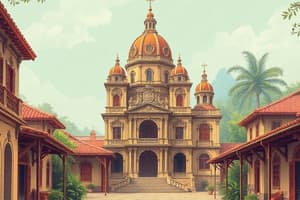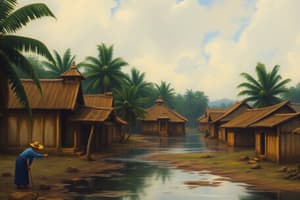Podcast
Questions and Answers
What role does the Datu primarily hold during times of conflict?
What role does the Datu primarily hold during times of conflict?
- Magistrate
- Commander-in-chief (correct)
- Adviser to the Rajah
- Leader of maritime forces
Which title is given to the leader of maritime forces?
Which title is given to the leader of maritime forces?
- Panglima
- Datu
- Rajah Laut (correct)
- Wajir
What was the significance of Sayyid Abu Bakr in the Sultanate of Sulu?
What was the significance of Sayyid Abu Bakr in the Sultanate of Sulu?
- Leader of Bangsa Sug
- Currently reigning Rajah
- Established the Sultanate of Sulu (correct)
- First Datu of the region
Which of the following is NOT a role of the Datu?
Which of the following is NOT a role of the Datu?
What is the basic political unit in the Philippines according to pre-colonial structure?
What is the basic political unit in the Philippines according to pre-colonial structure?
What is one qualification of being a Datu?
What is one qualification of being a Datu?
Which of the following best describes the role of the Ruma Bichara?
Which of the following best describes the role of the Ruma Bichara?
Which social class is considered the aristocrats in the pre-colonial Philippine society?
Which social class is considered the aristocrats in the pre-colonial Philippine society?
What was the purpose of the newspaper La Solidaridad?
What was the purpose of the newspaper La Solidaridad?
Which of the following best describes the La Liga Filipina?
Which of the following best describes the La Liga Filipina?
What significant event is associated with August 19, 1896?
What significant event is associated with August 19, 1896?
What reform did the concept of 'Kalayaan' predominantly symbolize?
What reform did the concept of 'Kalayaan' predominantly symbolize?
Which of the following was NOT a goal of the La Liga Filipina?
Which of the following was NOT a goal of the La Liga Filipina?
What indicates the political legitimacy of the Sultanates during the colonial era?
What indicates the political legitimacy of the Sultanates during the colonial era?
What form of governance was proposed through the reforms mentioned?
What form of governance was proposed through the reforms mentioned?
What was a common characteristic of the Sultanates of Sulu and Maguindanao from the 1400s onwards?
What was a common characteristic of the Sultanates of Sulu and Maguindanao from the 1400s onwards?
Who is known as the 'Ama ng Katipunan'?
Who is known as the 'Ama ng Katipunan'?
What significant event is associated with December 15, 1897?
What significant event is associated with December 15, 1897?
Which government was established on May 24, 1898?
Which government was established on May 24, 1898?
What was the outcome of the First Philippine Republic in 1899?
What was the outcome of the First Philippine Republic in 1899?
Who served as the first Chief Justice as appointed by the Second Philippine Commission?
Who served as the first Chief Justice as appointed by the Second Philippine Commission?
Which group was united to fight for freedom as part of the Katipunan?
Which group was united to fight for freedom as part of the Katipunan?
What was significant about Aguinaldo's retreat to Biak-na-Bato?
What was significant about Aguinaldo's retreat to Biak-na-Bato?
What does the term 'KATAGALUGAN' refer to?
What does the term 'KATAGALUGAN' refer to?
What significant change did the Jones Law implement in the Philippine government?
What significant change did the Jones Law implement in the Philippine government?
What was the main purpose of the Hare Hawes Cutting Act?
What was the main purpose of the Hare Hawes Cutting Act?
Who was the leader of the 1934 Constitutional Convention that created the Philippine Constitution?
Who was the leader of the 1934 Constitutional Convention that created the Philippine Constitution?
Which event marked the end of the Spanish-American War and led to the signing of the Treaty of Paris?
Which event marked the end of the Spanish-American War and led to the signing of the Treaty of Paris?
What was a significant outcome of the Philippine Commonwealth under Manuel L. Quezon?
What was a significant outcome of the Philippine Commonwealth under Manuel L. Quezon?
Which law transitioned the Philippine government from a military to a naval base focus?
Which law transitioned the Philippine government from a military to a naval base focus?
What role did Manuel Roxas hold following the Second World War?
What role did Manuel Roxas hold following the Second World War?
Which significant feature was included in the 1935 Constitution approved by Franklin D. Roosevelt?
Which significant feature was included in the 1935 Constitution approved by Franklin D. Roosevelt?
Study Notes
Pre-Colonial Government
- The barangay was the basic political unit in the Philippines.
- Each barangay was an independent polity, exercising authority over its territory.
- Datus or chieftains implemented customary laws.
- The Datu served as the commander-in-chief during war.
- The Datu was responsible for the livelihood of the people.
Social Class
- The Maharlika were the elite or free men.
- Alipin were commoners and worked for the Maharlika.
Becoming A Datu
- One could become a Datu by blood inheritance or by being chosen.
- Qualitifications for a Datu included wisdom, wealth, and physical health.
The Sultanates
- In the 1400s, Sultanates of Sulu and Maguindanao emerged, characterized by religious ties.
- Sayyid Abu Bakr, a Muslim missionary, established the first Sultanate of Sulu.
- Jolo was the capital of Sulu.
- The Bangsa Sug (Sulu Nation) encompassed surrounding areas in Mindanao, Borneo, and Palawan.
- The Sultanate of Maguindanao was established by Sharif Muhammed Kabungsuwan in the 1500s.
Shariah Law
- Shariah Law guided the conduct of Muslims.
- It covered areas like marriage, financial laws, and halal certification.
Propaganda Movement
- Jose Rizal led the Propaganda Movement, seeking reforms for the Philippines.
- Filipino perspective of history: Colonialism disrupted the Philippines' development.
- The Propaganda Movement advocated for:
- The Philippines as a province of Spain.
- Equal rights and freedoms for Filipinos.
- Filipino representation in the Cortes (Spain's legislative body).
- Secularization of all parishes.
- Mariano Ponce, Graciano Lopez-Jaena, and Marcelo H. Del Pilar were other prominent figures in the movement.
- The La Solidaridad newspaper was used to disseminate ideas and views of the propagandists.
- Key figures like Jose Rizal, Mariano Ponce, Graciano Lopez-Jaena, and Marcelo H. Del Pilar advocated for fundamental reforms for the Philippines.
The Liga Filipina
- Jose Rizal organized the Liga Filipina in 1892, aiming to achieve:
- Peaceful reforms to end abuses and injustices.
- Unity among Filipinos.
- The Liga Filipinas was short-lived due to Spanish authorities' concerns.
La Katipunan
- Katipunan emerged as a secret society advocating for independence from Spain.
- It sought to achieve autonomy through revolution rather than peaceful reforms.
- The Katipunan consisted of members from: - Elite - Middle Class - Masses.
- Key members included:
- Andres Bonifacio, "Ama ng Katipunan" (Father of the Katipunan).
- Emilio Jacinto, "Utak ng Katipunan" (Brain of the Katipunan). - Gregoria de Jesus, "Lakambini ng Katipunan" (Lady of the Katipunan). - “KATAGALUGAN” referred to all Filipinos as a nation.
- The execution of Andres Bonifacio had a significant impact on the revolutionary's morale.
The Biak na Bato Republic
- The Biak-na-Bato Republic was established in Bulacan by Emilio Aguinaldo & his government in November 1897.
- It represented a short-lived Filipino government seeking independence.
- The Pact of Biak-na-Bato was signed in December 1897 to end hostilities between Filipinos and Spain.
- This resulted in Aguinaldo’s group going into exile in Hong Kong.
- The pact involved payment by Spain to end the conflict.
- The Biak-na-Bato Republic ended with the outbreak of the Philippine-American War.
The First Philippine Republic
- The First Philippine Republic was established in Malolos, Bulacan, in 1899.
- Malolos Congress: established laws for the independent Philippine government.
- Treaty of Paris (December 1898): Spain ceded the Philippines to the US.
- The Malolos Constitution was crafted in January 1899 to establish the independent First Philippine Republic.
American Colonial Administration
- Spanish-American War: began in April 1898.
- The US won the war and control of the Philippines.
- Dictatorial Government established by Aguinaldo in May 1898.
- June 12, 1898: Proclamation of Philippine Independence in Kawit, Cavite.
- First Philippine Commission established in 1899.
- Second Philippine Commission formed in 1900.
- Filipino politicians and lawmakers were appointed to the commission. They were granted greater autonomy, culminating in the establishment of the Commonwealth of the Philippines in 1935.
- Jones Law (1916) brought significant changes in the civil government.
1935 Constitution
- Hare-Hawes Cutting Act (1933): Proposed a 10-year preparatory period for Philippine independence & the formation of a Commonwealth government.
- Tydings-McDuffie Law (1934): Replaced the Hare-Hawes Cutting Act, establishing a transition government for the Philippines.
- Constitutional Convention (1934) was held with 202 delegates.
- It was headed by Claro M. Recto.
- The Constitution was created and approved by President FDR on March 23, 1935.
- Philippine Commonwealth (1935-1946).
Philippine Presidents of the Commonwealth Period
- Manuel L. Quezon (1935-1941):
- Elected president of the newly formulated Commonwealth.
- Reorganized the islands’ military defense system.
- Promoted settlements for landless peasants.
- Sergio Osmeña (1944-1946):
- Served as president during the Japanese Occupation.
- Took office after the liberation of the Philippines.
- Manuel Roxas (1946-1948):
- First president of the independent Republic of the Philippines.
Ferdinand Marcos Jr.
- Son of the former dictator Ferdinand Marcos Sr.
- “Bagong Pilipinas” is a recurring theme in his election campaign promises.
- He appointed himself as Secretary of Agriculture.
- He abolished the Presidential Anti-Corruption Commission, transferring it to the Office of the Deputy Executive Secretary for Legal Affairs.
"Sanduguan" and its Significance
- Filipinos used "Sanduguan" (Blood Compact) as a symbol of loyalty and unity.
- The "Sanduguan" ceremony involved the mixing of blood between two individuals as a gesture of alliance and commitment. It was a significant social practice in pre-colonial Philippines.
Kalayaan
- Established a newspaper to advocate for women's rights and liberation.
- Played a significant role in advocating women's issues and perspectives during the period.
The Cry of Pugad Lawin
- This marked the start of the Philippine Revolution against Spain in August 1896.
- The event is considered a significant turning point in the fight for Philippine independence.
The Tejeros Convention
- This convention aimed to establish a revolutionary government to replace the Spanish colonial regime.
- Andres Bonifacio's execution was controversial and a pivotal turning point in the revolution.
Notable Moments
- Quizon City, declared the capital of the Philippines in 1948.
- American bases remained in the Philippines, transitioning from military to naval bases in 1947.
The Fifth Republic
- The current Philippine political system, established in 1987.
- Aims to address issues of democracy and national development.
- Involves the election of a President and Vice President, as well as representation in the Senate and House of Representatives.
- The current administration is under Ferdinand Marcos Jr. - the son of former President Ferdinand Marcos Sr.
Studying That Suits You
Use AI to generate personalized quizzes and flashcards to suit your learning preferences.
Related Documents
Description
Explore the intricate political structures of pre-colonial Philippines, focusing on the barangay system and the roles of datus. Learn about social classes such as Maharlika and Alipin, and the emergence of Sultanates. This quiz tests your knowledge on the governance and societal organization of the era.




